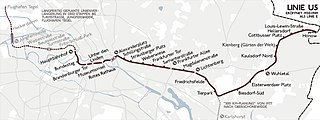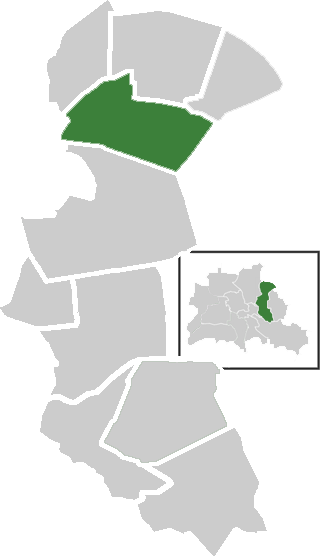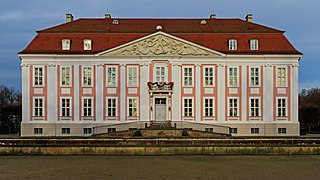
Marzahn-Hellersdorf is the tenth borough of Berlin, formed in 2001 by merging the former boroughs of Marzahn and Hellersdorf.

U5 is a line on the Berlin U-Bahn. It runs from Hauptbahnhof in Mitte eastwards through Alexanderplatz, Friedrichshain, Lichtenberg and Friedrichsfelde, surfaces in Biesdorf-Süd to pass Kaulsdorf and Hellersdorf above ground and finally reaches city limits at Hönow.
The U7 is a rail line on the Berlin U-Bahn. It runs completely underground for a length of 31.8 kilometres (19.8 mi) through 40 stations and connects Spandau, via Neukölln, to Gropiusstadt and Rudow. The line was originally the south-eastern branch of the Nord-Süd-Bahn (U6) that ran between the branching point at Belle-Alliance-Straße (Mehringdamm) and Grenzallee; however, in the 1960s, this stretch was separated from the rest of the line and extended at each end to form a new line. As of 2007, the U7 is Berlin's longest underground line, both in terms of absolute length and total travel time, and one of the longest (entire) subterranean lines in Europe.

Marzahn is a locality within the borough of Marzahn-Hellersdorf in Berlin. Berlin's 2001 administrative reform led to the former boroughs of Marzahn and Hellersdorf fusing into a single new borough. In the north the Marzahn locality includes the neighbourhoods of Bürknersfelde and Ahrensfelde, an overbuilt strip of land which once had belonged to the Brandenburg municipality of Ahrensfelde and was incorporated into Berlin in 1990.

Hönow is a village in Brandenburg, Germany, near the border of Berlin. Autonomous municipality until October 2003, it belongs to the municipality of Hoppegarten, in the district of Märkisch-Oderland; and its population is of 9,800 inhabitants.

Hellersdorf is a locality in the borough of Marzahn-Hellersdorf in Berlin. Between 1986 and Berlin's 2001 administrative reform, it was a borough in its own right, consisting of the current area of Hellersdorf as well as Kaulsdorf and Mahlsdorf.

Wuhletal is a railway station in the Marzahn-Hellersdorf district of Berlin. It is served by the S-Bahn line and the U-Bahn line .

Kienberg is a station on the U-Bahn in the German capital city of Berlin. It is located on the line.

Hellersdorf is a Berlin U-Bahn station located on the line.

Kaulsdorf is a locality within the borough Marzahn-Hellersdorf of Berlin. Kaulsdorf was incorporated into Greater Berlin by the Prussian Greater Berlin Act in 1920. From then on it belonged to the former borough of Lichtenberg until 1979, when it became part of the then borough of Marzahn. In 1986 Marzahn's eastern areas, including Kaulsdorf, were separated to form the new Borough of Hellerdorf, which was merged in 2001 to form the current borough. Kaulsdorf has, as of 2006, a population of 18,822 and encompasses an area of 8,7 km².

Raoul-Wallenberg-Straße is a railway station in the Marzahn-Hellersdorf district of Berlin. It is served by the S-Bahn line .

Berlin-Marzahn-Hellersdorf is an electoral constituency represented in the Bundestag. It elects one member via first-past-the-post voting. Under the current constituency numbering system, it is designated as constituency 85. It is located in eastern Berlin, comprising the Marzahn-Hellersdorf borough.

Neu-Hohenschönhausen is a German locality (Ortsteil) in the borough (Bezirk) of Lichtenberg, Berlin. Until 2001 it was part of the former Hohenschönhausen borough.

Bus transport is the oldest public transport service in Berlin, the capital city of Germany, having been introduced in 1846. Since 1929, services have been operated by the Berlin Transport Company, although during the Cold War-era division of the city they operated in West Berlin only. BVG's fleet consists of 1,300 vehicles, which cover 300,000 kilometres per day.

Mahlsdorf is a locality (Ortsteil) within the Berlin borough (Bezirk) of Marzahn-Hellersdorf. Until 2001 it was part of the former borough of Hellersdorf.

Biesdorf is a locality (Ortsteil) within the Berlin borough (Bezirk) of Marzahn-Hellersdorf. Until 2001 it was part of the former borough of Marzahn.

Friedrichsfelde is a German locality (Ortsteil) within the borough (Bezirk) of Lichtenberg, Berlin.

Falkenberg is a German locality (Ortsteil) within the borough (Bezirk) of Lichtenberg, Berlin. Until 2001, it was part of the borough of Hohenschönhausen.
The U11 line is a planned line of the Berlin U-Bahn.

The IGA Cable Car, also known as Berlin Cableway, IGA Ropeway or IGA Cableway, is a 1.58 km (0.98 mi)-long gondola lift line serving and crossing the Erholungspark Marzahn in Berlin, capital of Germany. Built for the Internationale Gartenausstellung 2017, an international horticultural exhibition, it is the first cableway opened in the German capital.
![]() line.
line.


















